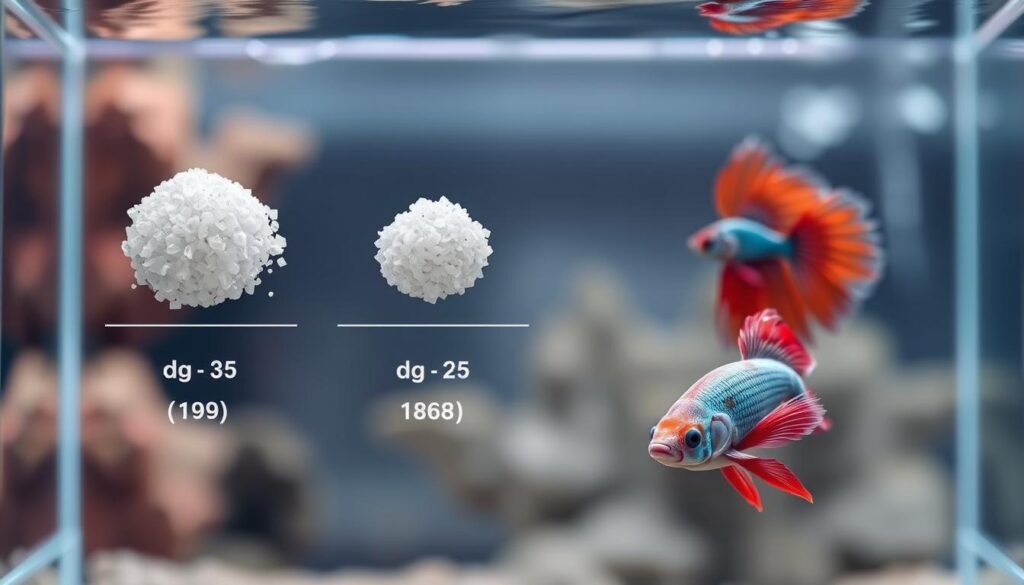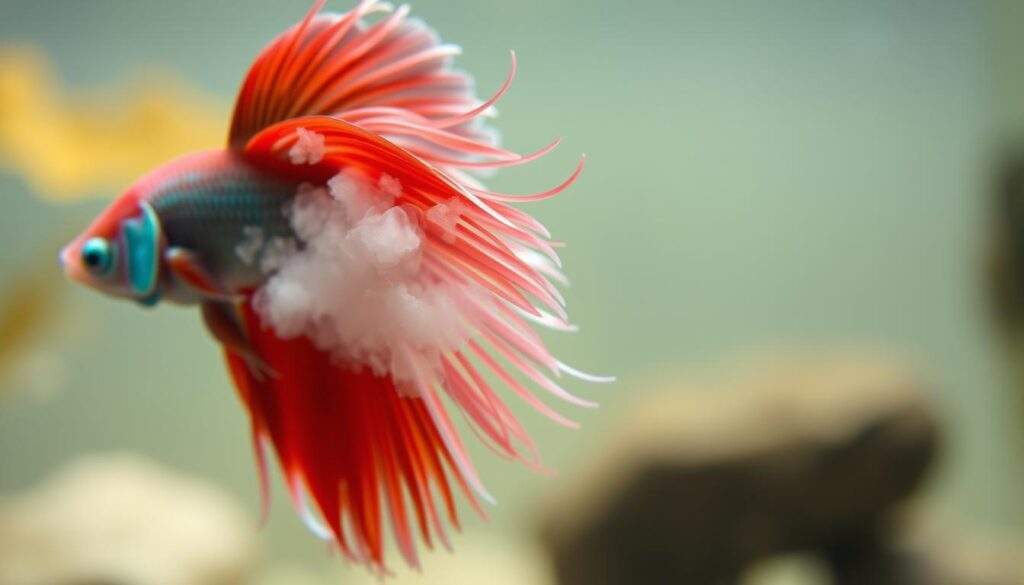If you’re a betta fish owner dealing with fin rot, you’re probably searching for safe and effective solutions. One of the most trusted remedies is aquarium salt. In this guide, you’ll learn how to use aquarium salt for betta fish fin rot to help your fish recover quickly. Whether you’re a beginner or an experienced aquarist, understanding the correct method is essential to avoid harming your betta while promoting healing.
Key Takeaways
- Understand the causes of fin rot in betta fish.
- Learn the benefits of using aquarium salt for treatment.
- Discover the proper dosage and administration of aquarium salt.
- Find out how to create a healthy environment for your betta fish to recover.
- Understand the importance of monitoring your betta fish’s progress during treatment.
What is Fin Rot in Betta Fish?
Fin rot is a common health issue in betta fish. It can be managed with the right care. This bacterial infection damages your betta’s fins and can lead to worse problems if not treated.
Common Causes of Fin Rot
Fin rot is mainly caused by bacteria that thrive in dirty water. Stress and injury also play a role. Poor water quality and not keeping the tank clean can stress your betta fish, making them more likely to get fin rot.
Identifying Fin Rot Symptoms
It’s important to spot fin rot symptoms early for effective treatment. The condition can get worse if not caught in time. Knowing the stages of fin rot helps you act fast.
Early Stage Symptoms
Early signs of fin rot include frayed fins and slight color changes. If you see these, act quickly to stop it from getting worse.
Advanced Stage Symptoms
Fin rot gets worse with time, causing severe fin damage. Fins can become very frayed or even fall off. In the worst cases, the infection can spread to the body, causing serious health issues.
Knowing the causes and symptoms of fin rot helps you treat and prevent it. This keeps your betta fish healthy and happy.
The Benefits of Aquarium Salt for Betta Fish
Aquarium salt is a great tool for treating fin rot in betta fish. It’s a natural and effective remedy.
It reduces bacterial growth, helps in healing, and lowers stress in betta fish. This makes it a powerful tool against fin rot.
How Salt Fights Bacterial Infections
Aquarium salt makes it harder for bacteria to grow. This lets the betta fish’s body fight off the infection better. Using aquarium salt for betta fish fin rot treatment has shown great results.
Salt vs. Commercial Medications
Aquarium salt is cheaper and easier to find than commercial meds. It’s also gentler on betta fish because it doesn’t add harsh chemicals. For betta fish fin rot treatment with salt, it’s as effective as commercial meds in many cases.
Selecting the Right Aquarium Salt
Choosing the right aquarium salt is key for treating betta fish fin rot. There are many options, but knowing the differences is important. This helps you make a good choice.
Different Types of Aquarium Salt
There are many types of aquarium salt, each with its own features. Pure sodium chloride-based salts are best for betta fish because they are gentle. It’s important to check the labels for additives or special conditions.
Here’s a look at some common aquarium salts:
| Type of Salt | Composition | Suitability for Betta Fish |
|---|---|---|
| Table Salt | Sodium chloride with additives | Not recommended due to additives |
| Sea Salt | Varied composition, may contain minerals | Not ideal due to potential mineral content |
| Reef Salt | Specifically designed for reef aquariums, may contain calcium | Not suitable due to additional minerals |
| API Aquarium Salt | Pure sodium chloride | Highly recommended |
What to Avoid When Buying Salt
When buying aquarium salt, stay away from products with additives or unnecessary ingredients. These can harm your betta fish or stress them out. Choose salts labeled as safe for betta fish or freshwater aquariums.
Also, be careful of very cheap salts. They might not be pure or could be contaminated. Always follow the manufacturer’s dosage instructions to avoid harming your betta.
Preparing for Salt Treatment
Getting ready for salt treatment is key to helping your betta fish get better from fin rot. Before starting, make sure your betta fish has a good place to stay.
Setting Up a Hospital Tank
A hospital tank is needed for treating fin rot with aquarium salt. It gives your betta fish a safe space to heal.
Essential Equipment Needed
You’ll need a heater to keep the water warm, a thermometer to check the temperature, and water conditioner to make the water safe.
Read Also Shocking Truth: How Big Can Betta Fish Get in a Tiny Bowl?
Ideal Tank Size and Setup
The best size for a hospital tank is 0.5-2 gallons. It’s big enough for your betta fish to swim but not too big. Make sure it has a secure lid to stop your fish from jumping out.
Optimal Water Parameters
Keeping the water just right is very important during salt treatment. The temperature should be between 76-78°F. This is perfect for betta fish and helps them heal faster.
| Parameter | Ideal Range | Importance |
|---|---|---|
| Temperature | 76-78°F | High |
| pH | 6.5-7.5 | Medium |
| Water Hardness | Soft to Moderate | Medium |
By setting up a hospital tank with the right stuff and keeping the water perfect, you can help your betta fish get better from fin rot.
How to Use Aquarium Salt for Betta Fish Fin Rot
Using aquarium salt correctly is key to treating fin rot in betta fish. It can greatly improve your betta’s health and fix its fins.
Step-by-Step Treatment Process
To treat fin rot, follow a detailed process. First, dissolve the aquarium salt properly. This avoids sudden water chemistry changes that stress your betta.
Also Read Betta Fish Minimum Tank Size Mistakes That Are Hurting Your Pet
Dissolving Salt Properly
Dissolve the recommended aquarium salt in a bit of water from the hospital tank. This prevents undissolved salt from harming your betta’s gills or fins. Make sure the salt is fully dissolved before adding it.
Adding Salt to the Tank
After dissolving the salt, slowly add it to the hospital tank. Watch your betta for stress signs. It’s important to add the salt mixture gradually to avoid shocking your fish.
Daily Monitoring During Treatment
Monitoring daily is key during treatment. Do a 100% water change every day, adding the right amount of aquarium salt. Watch your betta closely for any changes in its condition.
By following these steps and keeping up with treatment, you can treat fin rot in your betta fish with aquarium salt. Regular checks and adjustments will help get the best results.
Correct Aquarium Salt Dosage for Betta Fish
To treat fin rot in Betta fish with aquarium salt, knowing the right amount is key. The correct amount is important for treating the fin rot without harming your fish.
Standard Dosage Guidelines
The usual dose for treating Betta fish with aquarium salt is 1 teaspoon of salt per gallon of water. This amount is safe and works well for mild fin rot. Make sure to use high-quality aquarium salt without additives or anti-caking agents.
Adjusting Dosage for Severe Cases
If your Betta fish has severe fin rot, you might need to use 2-3 teaspoons per gallon. But, watch your fish closely for signs of stress or salt sensitivity.
Maximum Safe Concentration
The safest amount of aquarium salt for Betta fish is usually 3 teaspoons per gallon. Using more can be toxic and harm your fish.
Read Also Are LED Lights for Betta Fish Tanks Harming Your Pet?
Gradual Increase Method
For severe fin rot, slowly increase the salt dose. Start with 1 teaspoon per gallon and add 1/2 teaspoon every 24 hours until you reach 3 teaspoons. This slow increase helps reduce stress on your Betta fish.

By following these guidelines and watching your Betta fish’s response, you can use aquarium salt to treat fin rot. This will help your fish get better.
Treatment Duration and Maintenance
Treating fin rot in betta fish with aquarium salt needs a clear plan. You must watch the fish closely and keep the water clean.
How Long to Continue Salt Treatment
The treatment usually lasts 7-10 days, based on how bad the fin rot is. It’s key to finish the treatment to get rid of the infection. If you stop too soon, the fin rot might come back.
Water Change Schedule During Treatment
Changing the water often is very important during treatment. I suggest doing 100% water changes daily. This keeps the water clean and removes any extra salt.
Partial vs. Complete Water Changes
It’s better to do full water changes during treatment. This way, you get rid of all the bad stuff and extra salt. It helps avoid any problems.
Re-adding Salt After Water Changes
After changing the water, you need to add salt again. Use the same amount as before to keep the treatment working right.
Stick to this treatment plan and keep the water clean. This way, you can cure fin rot in your betta fish with aquarium salt.
Complementary Treatments with Aquarium Salt
When treating betta fish fin rot with aquarium salt, it’s key to think about other treatments too. Aquarium salt helps fight bacterial infections and aids in healing. But, other treatments can help your betta fish recover faster.
Compatible Medications
Some medicines work well with aquarium salt to treat fin rot. Antibacterial medications like kanamycin or melafix can be used with aquarium salt. But, make sure to pick medicines made for aquarium salt and betta fish.
Here’s a table outlining some compatible medications:
| Medication Type | Compatibility with Aquarium Salt | Effectiveness Against Fin Rot |
|---|---|---|
| Kanamycin | Yes | High |
| Melafix | Yes | Moderate |
| Methylene Blue | No | Low |
Beneficial Additives During Treatment
Along with medicines, some additives can help during treatment. Probiotics keep your betta’s gut healthy, which helps overall health and recovery. Vitamins and supplements can also boost your betta’s immune system.

Monitoring Recovery Signs
Watching for recovery signs is key to helping your betta fish get better from fin rot with aquarium salt treatment. It’s important to see both visual and behavioral changes as the treatment goes on.
Visual Indicators of Healing
Seeing your betta’s fins grow back is a great sign of healing. At first, you might see less inflammation and redness. As it heals more, the fins will grow back slowly. Clear water and a healthy appetite are also good signs that your betta is getting better.
Behavioral Changes During Recovery
Besides what you see, changes in how your betta acts can also show it’s getting better. A recovering betta will swim more and show more interest in its tank. An increase in appetite is another big sign that the treatment is working. As your betta gets healthier, it will swim more strongly and explore its tank more.
| Signs of Recovery | Description |
|---|---|
| Fin Regrowth | Gradual regrowth of fins, indicating healing |
| Reduced Inflammation | Less redness and swelling around affected areas |
| Increased Activity | Betta fish becomes more active and exploratory |
| Improved Appetite | Betta fish shows more interest in feeding |
By watching for these signs closely, you can make any needed changes to the treatment. This helps ensure the best recovery for your betta fish.
Potential Risks and Side Effects
Aquarium salt is a good treatment for betta fish fin rot. But, it’s important to know the risks and side effects. Some betta fish may be sensitive to salt, showing different symptoms.

Signs of Salt Sensitivity in Bettas
Keep a close eye on your betta fish when using salt. Signs of salt sensitivity include lethargy, labored breathing, or less appetite. If you see these signs, act fast to protect your fish.
When to Discontinue Salt Treatment
If your betta fish shows salt sensitivity, stop the salt treatment right away. Also, do a partial water change to lower the salt in the tank. If the problem is severe, a vet who knows about fish can help.
Alternative Treatments for Severe Fin Rot
In cases where fin rot is severe, looking into alternative treatments is key. Aquarium salt is good for mild to moderate cases. But, severe cases need more powerful treatments.
Prescription Antibiotics
Prescription antibiotics can be a good choice for severe fin rot. Always talk to a vet before starting any antibiotic treatment. The wrong use can cause more problems. Antibiotics made for fish can fight off the bacteria causing fin rot.
Natural Remedies and Their Effectiveness
Some people use natural remedies like melaleuca oil or tea tree oil for fin rot. These have antimicrobial properties. But, their strength can vary, and they might not work as well as antibiotics. It’s important to know the pros and cons before trying natural remedies.
When looking at other treatments, watch your betta fish closely. You might need to change the treatment plan. Sometimes, mixing treatments is the best way to help your fish get better.
- Monitor your betta fish’s condition closely during treatment.
- Consult a veterinarian before using prescription antibiotics.
- Research natural remedies thoroughly before use.
Conclusion
Treating fin rot in betta fish with aquarium salt is easy and effective. Knowing why fin rot happens and how to use aquarium salt helps your betta fish get better. It also keeps them healthy.
Using aquarium salt to treat fin rot in betta fish is straightforward. I’ve explained how to do it, from picking the right salt to watching your fish’s health. This ensures a smooth treatment process.
By following these steps and using aquarium salt as instructed, you can cure fin rot. Also, keep the water quality good and watch your betta fish closely during treatment.
In short, aquarium salt is a great way to treat fin rot in betta fish. With the right care and use, your betta fish can overcome fin rot and live well. Aquarium salt is a trusted method for treating fin rot in betta fish.

